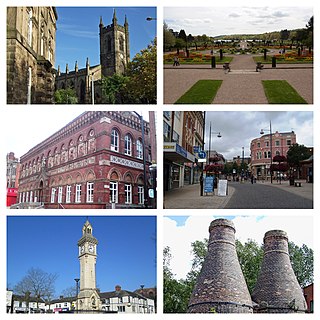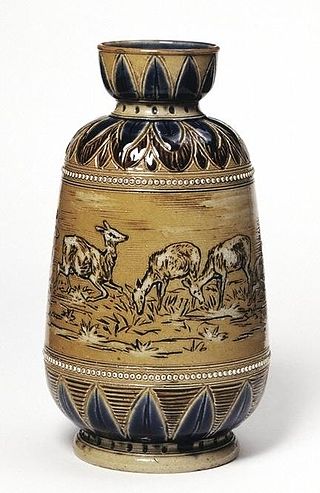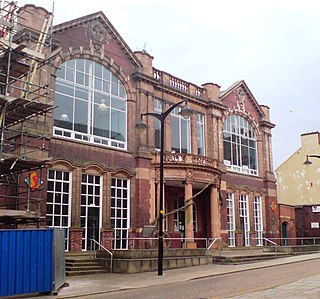Related Research Articles

Stoke-on-Trent is a city and unitary authority area in Staffordshire, England, with an area of 36 square miles (93 km2). In 2021, the city had an estimated population of 258,400. It is the largest settlement in Staffordshire and is surrounded by the towns of Newcastle-under-Lyme, Alsager, Kidsgrove and Biddulph, which form a conurbation around the city.

Biddulph is a town in Staffordshire, England, 8.5 miles (14 km) north of Stoke-on-Trent and 4.5 miles (7 km) south-east of Congleton, Cheshire.

Kidsgrove is a town in the borough of Newcastle-under-Lyme, Staffordshire, England, on the Cheshire border. It is part of the Potteries Urban Area, along with Stoke-on-Trent and Newcastle-under-Lyme. It has a population of 26,276. Most of the town is in the Kidsgrove ward, whilst the western part is in Ravenscliffe.

Burslem is one of the six towns that along with Hanley, Tunstall, Fenton, Longton and Stoke-upon-Trent form part of the city of Stoke-on-Trent in Staffordshire, England. It is often referred to as the "mother town" of Stoke on Trent.
Arthur Berry was an English playwright, poet, teacher and artist, who was born in Smallthorne, Stoke-on-Trent. His individual creative work became deeply rooted in the culture, people and landscape of the industrial pottery town of Burslem.

Stoke-on-Trent North is a constituency represented in the House of Commons of the UK Parliament since 2019 by Jonathan Gullis, a member of the Conservative Party.

Hugh Bourne along with William Clowes was the joint founder of Primitive Methodism, the largest offshoot of Wesleyan Methodism and, in the mid-19th century, an influential Protestant Christian movement in its own right.

Smallthorne is an area in the city of Stoke-on-Trent in Staffordshire, England. It is in the north-east of the city, near Burslem. Smallthorne borders Bradeley and Chell in the north, Norton-in-the-Moors in the east, Sneyd Green in the south, and Burslem in the west.

Royal Doulton is an English ceramic and home accessories manufacturer that was founded in 1815. Operating originally in Vauxhall, London, and later moving to Lambeth, in 1882 it opened a factory in Burslem, Stoke-on-Trent, in the centre of English pottery. From the start, the backbone of the business was a wide range of utilitarian wares, mostly stonewares, including storage jars, tankards and the like, and later extending to drain pipes, lavatories, water filters, electrical porcelain and other technical ceramics. From 1853 to 1901, its wares were marked Doulton & Co., then from 1901, when a royal warrant was given, Royal Doulton.

Burslem School of Art was an art school in the centre of the town of Burslem in the Potteries district of England. Students from the school played an important role in the local pottery industry. Pottery was made on the site of the school from the early Middle Ages. The venue was refurbished and re-opened for the arts in 1999.

Mow Cop is a village split between Cheshire and Staffordshire, and therefore divided between the North West and West Midlands regions of England. It is 24 miles (39 km) south of Manchester and 6 miles (9.7 km) north of Stoke-on-Trent, on a steep hill of the same name rising to 335 metres (1,099 ft) above sea level. The village is at the edge of the southern Pennines, with the Cheshire Plain directly to the west. For population details taken at the 2011 census, see Kidsgrove. The Cheshire section is the highest settlement within the county of Cheshire.
William Clowes (1780–1851) was one of the founders of Primitive Methodism.
Gordon Mitchell Forsyth (1879–1952) was a Scottish ceramic designer and fine artist and art education innovator.
John Shelton was an English painter and ceramic artist born in Shelton, Stoke-on-Trent.

Chell is a suburb of the city of Stoke-on-Trent in the ceremonial county of Staffordshire, England, that can be subdivided into Little Chell, Great Chell and Chell Heath. It lies on the northern edge of the city, approximately 1-mile (1.6 km) from Tunstall, 2 miles (3.2 km) from Burslem and 3 miles (4.8 km) from the county border with Cheshire. Chell borders Pitts Hill to the west, Tunstall to the south west, Stanfield and Bradeley to the south, with the outlying villages of Packmoor and Brindley Ford to the north and Ball Green to the east. Since 2011 the area has been divided into the electoral wards of Bradeley & Chell Heath, Great Chell & Packmoor and Little Chell & Stanfield.

Moira Forsyth was an English stained-glass artist. Her father was Gordon Forsyth a Scottish ceramics designer, stained-glass artist, and teacher. They both made works for the St. Joseph's Church in Burslem, Stoke-on-Trent, Staffordshire. She made her name for her stained-glass works, such as those found at Guildford Cathedral, Norwich Cathedral and Eton College Chapel.
Jack Reacher is a series of novels, novellas and short stories by British author Jim Grant under the pen name Lee Child. As of January 2022, the series includes 28 books and a short story collection. The book series chronicles the adventures of Jack Reacher, a former major in the United States Army Military Police Corps now a drifter, roaming the United States taking odd jobs and investigating suspicious and frequently dangerous situations, some of which are of a personal nature. The Reacher series has maintained a schedule of one book per year, except for 2010, when two installments were published.
Baddeley Edge is a hamlet in the north of the city of Stoke-on-Trent, in the north of the county of Staffordshire.

David Dougall Williams FRSA was a Cheshire-born artist and art teacher who lived and worked in Dundee.
Richard Arthur Ledward, born in the Staffordshire Potteries in England, was a sculptor and teacher of pottery modelling.
References
- ↑ Vann, Philip (2004). Face to face: British self-portraits in the twentieth century. Sansom & Company. pp. 261–. ISBN 9781904537083 . Retrieved 26 May 2013.
- 1 2 3 4 The Guardian, 31/05/2012, "Jack Simcock obituary", 14/05/2013
- 1 2 The Sentinel, 15/05/2012, " Artist Jack Simcock dies on eve of exhibition ", 14/05/2013
- ↑ 38 artworks by or after Jack Simcock , Art UK . Retrieved 9 January 2014.
- ↑ "Catalogue record for "Midnight till three"". British Library. Retrieved 9 January 2014.